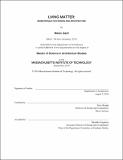| dc.contributor.advisor | Terry Knight. | en_US |
| dc.contributor.author | Gazit, Merav | en_US |
| dc.contributor.other | Massachusetts Institute of Technology. Department of Architecture. | en_US |
| dc.date.accessioned | 2017-03-10T15:04:41Z | |
| dc.date.available | 2017-03-10T15:04:41Z | |
| dc.date.copyright | 2016 | en_US |
| dc.date.issued | 2016 | en_US |
| dc.identifier.uri | http://hdl.handle.net/1721.1/107310 | |
| dc.description | Thesis: S.M. in Architecture Studies, Massachusetts Institute of Technology, Department of Architecture, 2016. | en_US |
| dc.description | Cataloged from PDF version of thesis. | en_US |
| dc.description | Includes bibliographical references (pages 47-49). | en_US |
| dc.description.abstract | For over a decade, we have witnessed a new emphasis in digital architecture on modes of production and material-based approaches rather than on form, geometry, and representation alone. As a result, fabrication techniques and material systems generally not accessible to architects can now become an integral part of the design workflow. In this thesis, I explore the possibility of using bio-materials for design and architecture, placing a special emphasis on bio-materials that grow from a few bacteria cells. As a case study, I present the development of a bio-pneumatic cellular envelope that functions- through pneumatic and fluid actuations -as a system for growing, shaping, and enhancing the material properties of 3D bacterial cellulose inflated structures. Bacterial cellulose is produced by bacteria that create membranes of cellulose, layer by layer, in a fashion similar to additive manufacturing. The cellulose can be grown into virtually any given shape in a process that requires almost no waste or energy. The great tensile strength, biodegradability, and renewable nature of bacterial cellulose make it especially suitable as an environmentally-friendly material for design and architecture. The bio-pneumatic system is computationally controlled, enabling a measured flow of air and liquids in and out of each cell in the system. This facilitates the creation of cellulose-based material with varied properties in each cell. Throughout the entire timeline of material production, the envelope is a tangible architectural object that changes in accordance with production phases: the material transforms from a liquid medium to a hydrogel composite to a pneumatic aerogel. The emphasis is therefore not merely on the final artifact but on the process of making itself. This research presents the process of making matter as a design process. It stands at the intersection of design, architecture materials science, and biology, and therefore leaps naturally between scales, from nano to macro, and opens up new design possibilities. The ability to shape material behavior at different scales enables a unique construction of material properties and informs processes and outcomes at the architectural level. A key interest in this thesis is exploring the tension between making and growing by confronting conventional methods of architectural making. Such methods require extensive preliminary planning, detailing, and tolerance handling for a precise assemblage of parts and components, and result in clear and pure aesthetics. Bio-materials and their changing nature, on the other hand, may present irregularity and imprecision, often resulting in "impure" aesthetics, are vulnerable to contamination and decay, yet also display the ability to renew and self-heal. | en_US |
| dc.description.statementofresponsibility | by Merav Gazit. | en_US |
| dc.format.extent | 49 pages | en_US |
| dc.language.iso | eng | en_US |
| dc.publisher | Massachusetts Institute of Technology | en_US |
| dc.rights | MIT theses are protected by copyright. They may be viewed, downloaded, or printed from this source but further reproduction or distribution in any format is prohibited without written permission. | en_US |
| dc.rights.uri | http://dspace.mit.edu/handle/1721.1/7582 | en_US |
| dc.subject | Architecture. | en_US |
| dc.title | Living matter : biomaterials for design and architecture | en_US |
| dc.type | Thesis | en_US |
| dc.description.degree | S.M. in Architecture Studies | en_US |
| dc.contributor.department | Massachusetts Institute of Technology. Department of Architecture | |
| dc.identifier.oclc | 972735626 | en_US |
